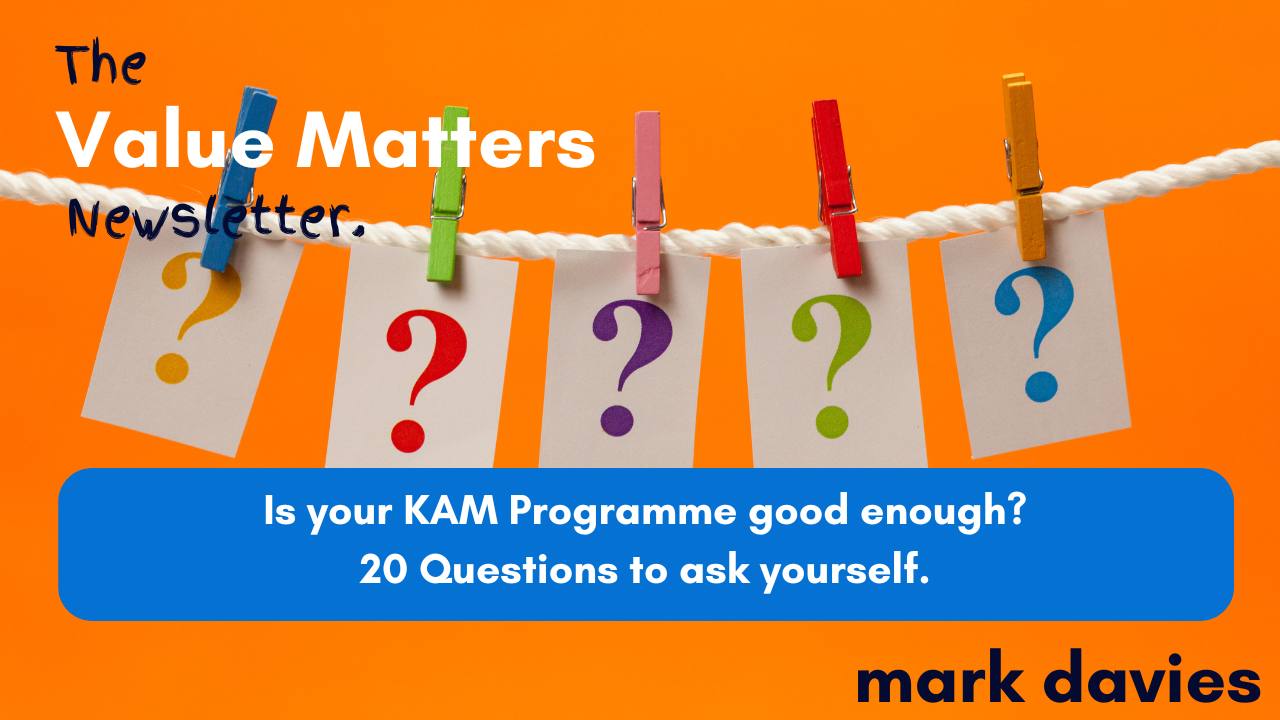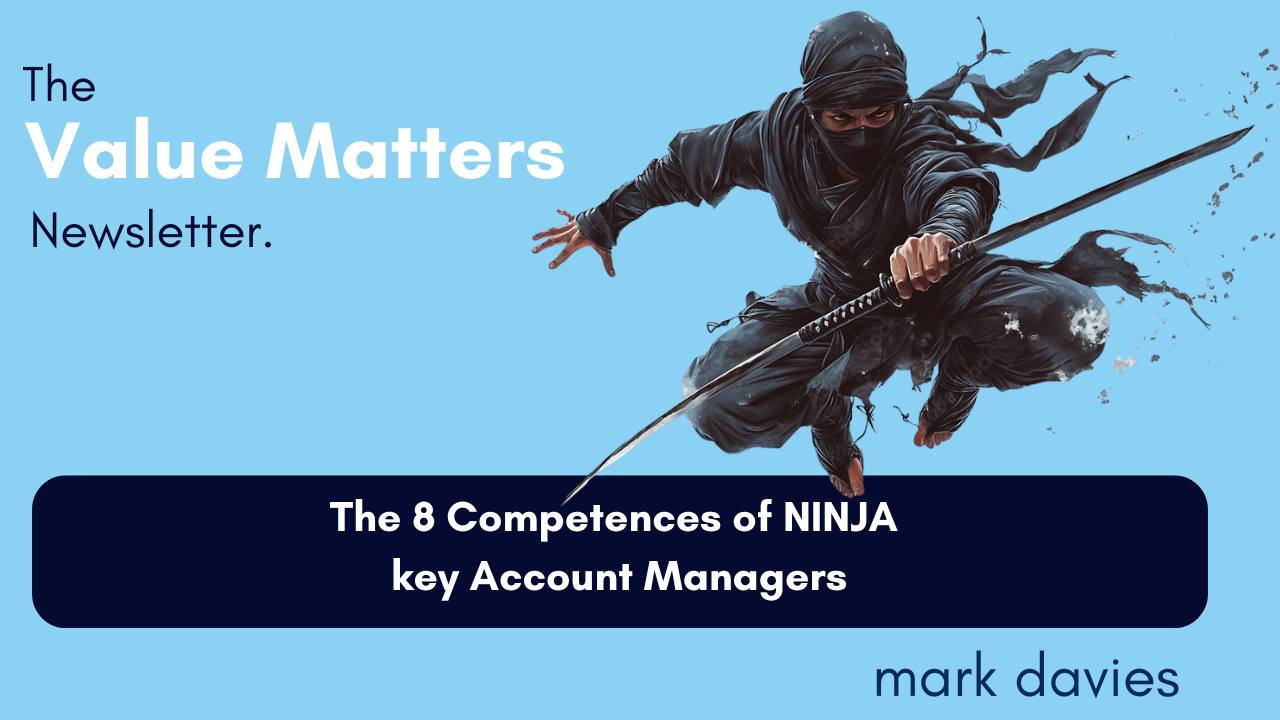Accelerating sales growth with the Value-Based KAM Framework
INTRODUCTION
The Uncomfortable Truth About KAM
Here's a statistic that should make every Chief Revenue Officer pause: according to Gartner, 80% of key account management programs fail to deliver their expected results.
Four out of five sales organisations find themselves in the frustrating cycle of rebuilding their KAM programmes every few years to address consistent underperformance.

Yet KAM has never been more critical. We're operating in a VUCA world: volatile, uncertain, complex, and ambiguous. Product life cycles are shrinking, customers are more demanding and aggressive in their expectations, and the traditional approaches to managing strategic relationships are simply not working.

In my previous article "Rethinking KAM," I outlined why this matters and what needs to change. Today, I want to introduce you to something practical: a roadmap that can move your organisation from the failing 80% into the successful 20%. It's called the Value-Based KAM Framework, and it represents a fundamental shift in how we approach key account management.

In his book "Thank You for Being Late," Thomas Friedman boils VUCA down to 3 main forces.
These are: M1 - Moore's Law, a doubling in power and halving in cost, first proposed by Moore of Intel. With the Ai revolution, technology is shifting faster than ever.

M2 - Markets. Take a look at the chaos being caused by the tariff uncertainty being pushed globally through 2025.
M3 - Mother Nature. Global warming and severe shifts in weather (including fire, drought, flooding, and soaring temperatures) are having a long, draining impact on organisations and individuals alike.
These 3M observations need constant reviewing and adjustment of strategies across supply chains.
Key Account Managers are becoming the essential "architects" navigating these shifting storms, but they need a guide to help them.
The Value-Based KAM Framework is that navigation tool.
Beyond the four blocks - A practical framework
The "Rethinking KAM" paper established four essential building blocks for high-performing KAM organisations:

- Offer Development & Innovation (the most important thing)
- Value-Based KAM (orchestrated by the people who make hard things happen)
- Key Account Leadership (the hardest thing - aligning an organisation to think, support and operate in ways that enable value-based business)
- Strategy (the roadmap that leadership writes to transition to a value-based business)
But frameworks without implementation guidance remain theoretical exercises. That's where the Value-Based KAM Framework comes in.
What this means for you as a B2B practitioner:
Stop treating KAM as relationship management with better account plans. Start treating it as a systematic approach to creating, selling, and delivering measurable value that your competitors cannot match.
Your secret weapon: The Value-Based KAM Framework
If you want to transition your organisation to value-based KAM, your best chance of success lies with your Key Account Managers. They are your secret weapon, but only if you provide them with the right guidelines and methodology.
The Value-Based KAM Framework gives practising Key and Strategic Account Managers a systematic approach built around three phases and seven steps. It's designed to be practical, not theoretical. Every technique I'll describe has been tested in real organisations dealing with real customers in challenging market conditions.
The three phases explained:

PHASE 1: Offer Development & Innovation (ODI) This phase focuses on understanding the customer deeply, using innovation techniques to create unique offers, and expressing these as high-impact customer value propositions.
PHASE 2: Agreement Here's the reality: no matter how strong your value proposition, you still need to sell it. This phase involves selling the idea internally first, then seeking agreement with appropriate leaders in the customer's business.
PHASE 3: Value Delivery Value-based business doesn't stop at the sale. Both you and your customer want to see that the offer delivers the promised results. Too many organisations fail to measure and report the value they deliver, and it simply "evaporates."
What this means for you as a B2B practitioner: Think of KAM as a systematic process, not an art form. Each phase has specific outputs and success criteria. Your Key Account Managers need to master all three phases to be truly effective.
The seven steps (expanded)

Phase one (Offer Development & Innovation) - ODI
Step 1: Value-Needs Analysis This is where serious KAM begins. You must establish where your customer is today as they pursue their strategic and operational objectives. How effective is your current offer in meeting their needs?
The critical breakthrough comes when you describe a compelling "Future State" - what could things look like if your offer is accepted? The gap between today's customer position and your value-adding future state becomes your opportunity landscape.
Make that future state strong, compelling, and attractive. Better than your competition's vision, and something customers see as both tangible and aspirational.
Step 2: Offer Ideation. Your offer comprises the multi-faceted elements you use to deliver value: products, services, commercial terms, access channels, people, processes, and brand messages. A whole suite of techniques and tools is available at this stage.

This is where true competitive advantage occurs. Get offer ideation right, and you build the engine to continually win sustainable business. The techniques are extensive and will be covered in detail in my forthcoming book, but the principle is clear: standard offerings rarely win strategic business.
Step 3: Customer Value Proposition There's a crucial difference between your offer and your customer value proposition. Your offer contains all the multi-faceted elements. Your customer value proposition sits on top of the offer as an executive summary that communicates a complex offer succinctly and with impact.
No longer than one page, the customer value proposition takes time to create and define properly. It's not marketing copy; it's a strategic document that will guide your entire approach to the customer.
What this means for you as a B2B practitioner: Stop presenting product features and benefits. Start presenting future states and measurable value outcomes. Your value proposition should answer: "What will be different for this customer if they choose us?"
Phase Two - Agreement
Step 4: Value-Pitching & Value-Selling: Here's where KAM gets interesting. You're selling to two parties, and you must succeed with both.
Value-Pitching involves selling your idea and customer value proposition to your own organisation first. Why? Your idea may contain elements your organisation cannot support. It may not be profitable, sustainable, or significant enough. Ask yourself: "Is the juice worth the squeeze?"
Good Key Account Managers know how to lead internal teams to create unique customer value propositions. They sell internally and align their leadership teams to support the offer. If investment is needed, they make the business case and deliver the pitch.
Value-Selling means taking the idea to the customer. Typically, the greater the value, the harder the sell. If you're seeking sign-off for larger expenditures with payback in areas such as improved cash flow or increased sales, the value sale must be made to senior personnel, including C-suite and divisional heads.
This isn't traditional selling to a local buyer or general manager. It's a complex, cross-functional selling process that can take several months. Value-selling requires investment and highly capable Key Account Managers to lead the conversations.
As I wrote in "Infinite Value,"
Value-based selling involves "Different Conversations, With Different People, About Different Things."
What this means for you as a B2B practitioner: Develop your internal selling skills as much as your customer-facing ones. Half of value-based KAM success happens inside your own organisation.
Phase 3 Value Delivery
Just because a sale has been made, the work doesn't stop. The Key Account Manager remains responsible for this business and must ensure all promises are delivered as agreed.
Step 5: Customer Value-Capture: Value delivery becomes easier as your customer value proposition gets stronger. Why? Because a robust value proposition states the measures that will be tracked within the text.
If you're promising to save energy costs, increase machine availability, decrease downtime, or reduce scrap, these become your customer value measures. They're not arbitrary metrics; they're the specific outcomes you committed to deliver.
Step 6: Supplier Value-Capture: Similarly, if you promised your own company increased sales, improved profit, reduced debtor days, or stronger relationships, these should be measured as well. Remember that internal business case you made? Now you need to prove it worked.
Step 7: Performance Review: Coaching Key Account Managers is a critical activity that seldom happens effectively. This connects back to Key Account Leadership - "the hardest thing."
Regular reviews against performance criteria for generating business with each strategic customer should occur. This combines hard sales data with softer aspects like relationship strength, customer understanding, and ability to generate ideas that beat competition.
Performance reviewing closes the loop of strategic performance, "customer by customer," and evaluates both the Key Account Manager and the supporting team.
What this means for you as a B2B practitioner: Build measurement and review into your KAM approach from day one. Value that isn't measured and communicated tends to fade from the customer's consciousness.
Why this framework matters now
The business environment isn't getting simpler. VUCA conditions are here to stay. Customers are more sophisticated, more demanding, and have more choices than ever before. Traditional KAM approaches - built around relationship management and account planning - simply aren't sufficient.
The Value-Based KAM Framework addresses the core challenge that Paulo Guenzi identified: "If I create a solution for my customer, paradoxically I create a problem for my own company." Most organisations are built to market and sell products. Value-based KAM requires building strategies around each customer, which is a fundamentally different business model.
This framework provides the systematic approach needed to make that transition successfully.
Getting started: Your next steps.
The Value-Based KAM Framework isn't just theory. It's a practical methodology that can be implemented systematically across your key account portfolio. Each of the seven steps has supporting techniques and tools that help Key Account Managers strategise, create, design, and lead business growth with strategic customers.
The framework recognises that Key Account Managers need guidelines and support to become effective. They are indeed your secret weapon, but only when properly equipped and supported.
What this means for you as a B2B practitioner: Start with one strategic customer. Apply the framework systematically. Measure the results. Then scale across your portfolio. This isn't about perfection from day one; it's about consistent improvement over time.
A portfolio of techniques and models
Behind each of the three phases and seven steps lies a comprehensive portfolio of techniques and models. From value-needs analysis methodologies to offer ideation tools, from internal selling frameworks to value measurement systems, there's substantial depth to explore.
Future Value Matters newsletters will provide detailed descriptions of these techniques. I'm also writing a comprehensive guide that will give practitioners everything they need to implement value-based KAM successfully.
Keep reading to build your knowledge of this elegant and essential approach to growing your B2B business. The organisations that master value-based KAM will have a sustainable competitive advantage that's difficult for competitors to replicate.
The bottom line
Eighty percent of KAM programmes fail because they're built on outdated assumptions about what customers value and how business gets done in strategic relationships. The Value-Based KAM Framework provides a practical alternative that can move your organisation into the successful 20%.
The framework is systematic without being rigid, comprehensive without being overwhelming, and practical without sacrificing strategic thinking. Most importantly, it's designed for the VUCA world we actually operate in, not the stable world we wish we had.
Your Key Account Managers really are your secret weapon. The question is: are you giving them the tools and guidance they need to succeed?
Want to get involved?
If you would like to try out the Value-Based KAM Framework with one or two of your customers, DM me and we can discuss ways that you can get involved.
While I am in the "Trest Phase" with the model, I am offering attractive options for coaching and training sessions for KAM teams.
Interested? get in touch!
[email protected]






Responses